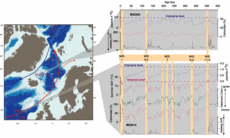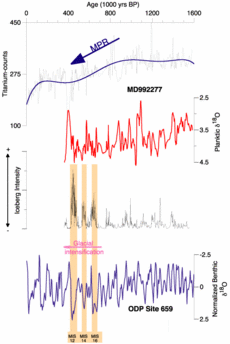A number of new insights were obtained: Regional differences of interglacial climate in the subpolar and polar North Atlantic became obvious. During the past 450,000 years the polar sector was characterized by only 3 pronounced warm periods, whereas interglacial climates occurred more frequently in the subpolar regions. Moreover, in the Northern Hemisphere a clear intensification of glacial and interglacial conditions during the course of the so-called mid-Pleistocene Revolution (MPR) is indicated (Fig. 2).
Literature
Bauch H.A. and Erlenkeuser H. (2003) Interpreting glacial-interglacial changes in ice volume and climate from subarctic deep water foraminiferal δ18O. In: Earth's Climate and Orbital Eccentricity: The Marine Isotope Stage 11 Question, edited by Droxler A.W., Poore R.Z., Burckle L.H.. American Geophysical Union Monograph Series, Washington, D. C., 137, 87-102.
Bauch H.A., Erlenkeuser, H., Fahl, K., Spielhagen, R.F., Weinelt, M.S., Andruleit, H. and Henrich, R. (1999) Evidence for a steeper Eemian than Holocene sea surface temperature gradient between Arctic and sub-Arctic regions. Palaeogeography, Palaeoclimatology, Palaeoecology 145, 95-117.
Bauch H.A., Erlenkeuser H., Helmke J.P. and J. Thiede (2000) A Paleoclimatic Evaluation of Marine Oxygen Isotope Stage 11 in the high-northern North Atlantic (Nordic Seas). Global and Planetary Change, 24 (1), 27-39.
Helmke J.P. and H.A. Bauch (2002) Glacial-interglacial carbonate preservation records in the Nordic Seas. Global and Planetary Change, 33, 15-28.
Helmke J.P. and H.A. Bauch (2003) Comparison of conditions between the polar and subpolar North Atlantic region over the last five climate cycles. Paleoceanography, 18 (2), 1036, doi:10.1029/2002PA000794.
Helmke J.P., Bauch H.A. and H. Erlenkeuser (2003) Development of glacial and interglacial climate conditions in the Nordic seas between 1.5 and 0.35 Ma. Quaternary Science Reviews, 22, 1717-1728.
Helmke J.P., Bauch H.A., Röhl U. and A. Mazaud (2005) Changes in sedimentation patterns of the Nordic seas region across the Mid-Pleistocene. Marine Geology, 215, 107-122.
Kandiano E.S. and H.A. Bauch (2003) Surface ocean temperatures in the Northeast Atlantic during the last 500,000 years: Evidence from foraminiferal census data. Terra Nova, 4, 265-271.
Kandiano E.S., Bauch H.A. and A. Müller (2004) Sea surface temperature variability in the North Atlantic during the last two glacial-interglacial cycles: Comparison of faunal, oxygen isotopic and Mg/Ca-derived records Palaeogeography, Palaeoclimatology, Palaeoecology, 204 (1-2), 145-164.




